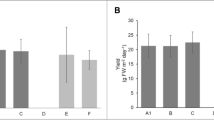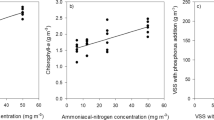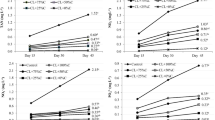Abstract
Water hyacinth,Eichhornia crassipes, growth and nutrient uptake rates, as influenced by different N sources and N transformations, were measured using microcosm aquaculture systems. Net productivity was highest in the system receiving equal amounts of NH4 + and NO3 - (at 10 mg N 1-1 each) and decreased in the order of NO3 -, NH4 +, urea (added at 20 mg N 1-1 each), and methane digestor effluent (at 6 mg N 1-1). During the first 7-wk study (average ambient air temperature was 26–28°C), biomass yields were in the range of 19–53 g dry wt m-2 day-1, while between the 8th and 12th wk (average ambient air temperature was 16–22°C), biomass yields were in the range of 10–33 g dry wt m-2 day-1. In the systems with either NH4 + or NO3 -, or both added in equal proportions, about 14–20% of the total yield was contributed by roots, whereas in the system with urea and digestor effluent, roots contributed about 23 and 44% of the total yield, respectively. Nitrogen and P uptake per unit area followed trends similar to biomass yields. Nitrogen uptake rates were in the range of 533–2, 161 mg N m-2 day-1 for the systems receiving NH4 +, NO3 -, and urea, while uptake rates were in the range of 124–602 mg N m-2 day-1 for the system receiving methane digestor effluent. Phosphorus uptake rates were found to be in the range of 59–542 mg P m-2 day-1. Under the most favorable conditions, maximum recorded biomass yield was 53 g dry wt m-2 day-1, with N and P removal rate of 2,161 mg N m-2 day-1 and 542 mg P m-2 day-1, indicating the potential of water hyacinth to produce large amounts of biomass which can be potentially used as a feedstock to produce methane.
Similar content being viewed by others
Literature Cited
A.P.H.A. 1971. Standard methods for the examination of water and wastewater. 13th ed. Amer. Publ. Health Assoc, Washington, DC.
Boyd, C. E. 1970. Vascular aquatic plants for mineral nutrient removal from polluted waters. Econ. Bot. 24: 95–103.
Bremner, J. M. 1965. Inorganic forms of nitrogen.In C. A. Black, Methods of Soil Analysis. Agron. 9: 1179–1237. Amer. Soc. Agron., Madison, WI.
Ornes, W. H., and D. L. Sutton. 1975. Removal of phosphorus from static sewage effluent by water hyacinths. Hyacinth Control 13: 56–58.
Reddy, K. R. 1983. Fate of nitrogen and phosphorus in a wastewater retention reservoir containing aquatic macrophytes. J. Environ. Qual. 12: (in press).
—, and L. O. Bagnall. 1981. Biomass production of aquatic plants used in agricultural drainage water treatment.In International Gas Res. Conf. Proc. Govt. Inst., Rockville, MD p. 668–681.
—, P.D. Sacco, D.A. Graetz, K.L. Campbell, and L.R. Sinclair. 1982. Water treatment by an aquatic ecosystem: Efficiency of nutrient removal by reservoirs and flooded fields. Environ. Mgmt. 6: 261–271.
Rogers, H. H., and D.E. Davis. 1972. Nutrient removal by water hyacinths. Weed Sci. 20: 423–428.
Ryther, J. H., L.D. Williams, M.D. Hanisak, R.W. Stenberg, and T.A. DeBusk. 1978. Biomass production by some marine and freshwater plants.In W. W. Shuster, Proc. Second Fuels from Biomass Symp., Rensselaer Polytechnic Inst., Troy, NY 2: 978–989.
Shiralipour, A., L.A. Garrard, and W.T. Haller. 1981. Nitrogen source, biomass production, and phosphorus uptake in water hyacinths. Aquatic Pl. Mgt. 19: 40–43.
Tucker, C. S. 1981. The effect of ionic form and level of nitrogen on the growth and composition ofEichhornia crassipes (Mart) Solms. Hydrobiologia (in press).
Wolverton, B. C, and R.C. McDonald. 1979. Water hyacinth (Eichhornia crassipes) productivity and harvesting studies. Econ. Bot. 33: 1–10.
Yount, J. L., and R. Crossman. 1970. Eutrophication control by plant harvesting. J. Water Poll. Cont. Fed. 42: 173–183.
Author information
Authors and Affiliations
Additional information
Florida Agricultural Experiment Stations Journal Series No. 4165.
Rights and permissions
About this article
Cite this article
Reddy, K.R., Tucker, J.C. Productivity and nutrient uptake of water hyacinth,Eichhornia crassipes I. Effect of nitrogen source. Econ Bot 37, 237–247 (1983). https://doi.org/10.1007/BF02858790
Received:
Accepted:
Issue Date:
DOI: https://doi.org/10.1007/BF02858790




